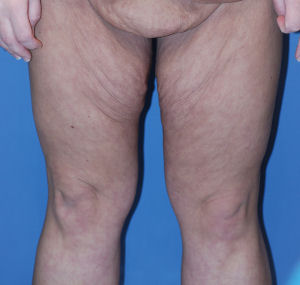|
|
 |
Back to Annual Meeting Program
Thigh Laxity after Massive Weight Loss: An Assessment of Utility Outcomes
Hani Sinno, MD,CM,MEng1, Ali Izadpanah, MD,CM,MSc2, Joshua Vorstenbosch, PhD1, Stephanie Thibaudeau, MD,CM1, Samuel J. Lin, MD, FACS1.
1McGill University, Montreal, QC, Canada, 2McGill University, Westmount, QC, Canada.
Background
The presence of excess skin following massive weight loss, particularly in the thighs, not only contributes to a negative body image but can also lead to functional deficits in mobility. Utility outcome studies have been used across numerous medical and surgical conditions. In the present study, we quantified the health state utility of living with excess skin in the thighs following massive weight loss in an attempt to objectively establish the burden on the quality of life in this patient population.
Method
Using visual analogue scale (VAS), time trade-off (TTO), and standard gamble (SG) the utility outcome scores for living with significant thigh laxity was compared with monocular, and binocular blindness from a prospective sample of medical students and the general population. Utility scores were compared using a paired t-test. Linear regression was performed using age, race, and education as independent predictors of each of the utility outcome scores.
Results
134 participants were enrolled over a six month period, of which 112 met inclusion criteria. The utility outcome scores for thigh lift (VAS, TTO, SG: 0.77 ± 0.15, 0.90 ± 0.11, 0.89 ± 0.14, respectively) were statistically different from binocular blindness (VAS, TTO, SG: 0.37 ± 0.18, 0.70 ± 0.23, 0.70 ± 0.26; p<0.001), but other than VAS (0.67 ± 0.15, p<0.001), similar to monocular blindness (TTO, and SG: 0.89 ± 0.13, and 0.81 ± 0.14, respectively; p>0.05). SG (0.89 ± 0.14 versus 0.97 ± 0.02; p=0.003) and TTO (0.89 ± 0.11 versus 0.95 ± 0.03; p=0.038) were different between general population and medical students, respectively, corresponding to 3.96 versus 1.80 years to sacrifice (p<0.05). Additionally, SG was higher in Caucasians versus non-Caucasians who were willing to accept an 8% chance of mortality compared to 15% ( p=0.001).
Conclusions
We have determined objective values regarding the utility outcomes of living with thigh laxity after massive weight loss. Our sample population if faced with this condition was willing to sacrifice 3.6 years of life and undergo a procedure with 11 percent chance of mortality. Objective values from utility studies are one form of quantifying patient burden with various conditions.  
Back to Annual Meeting Program
|








